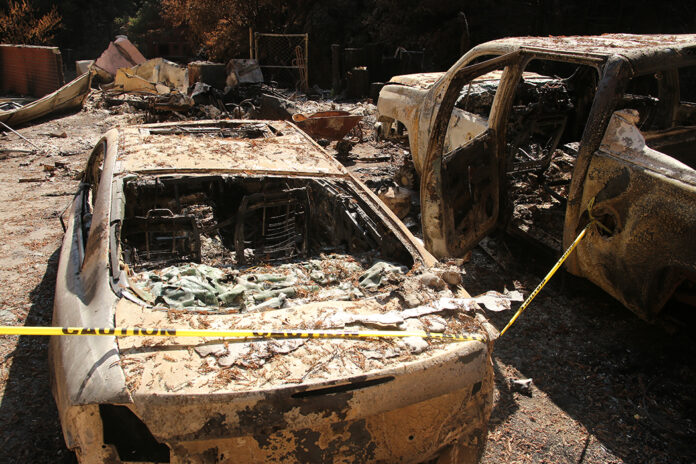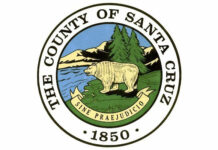
Editor’s note: This is the first entry in a multi-part series about debris flows and what local first responders are doing to prepare for a possible event.
Boulder Creek Fire Protection District Chief Mark Bingham has seen fire. For the better part of this fall, Bingham’s crew of 40-plus volunteers attacked the CZU August Lightning Complex fire up and down the mountain. Working in conjunction with a unified command team constructed of local departments, Cal Fire and outside agencies, Boulder Creek’s finest managed to stop the inferno’s advances toward Highway 9. Ultimately, the town was saved by collaborative efforts and the sheer force of will that relentlessly drove Bingham’s department night and day to stop the spread of the fire.
While stump fires still burn and smolder in the mountains above town, residents who lost their homes have begun the arduous process of clean up, weighing the benefits of rebuilding versus starting anew in another corner of the world. As tractors and backhoes sweep away the detritus of loss, a new threat is building on the hillsides: debris flows.
Bingham has also seen rain. The San Lorenzo Valley has endured its share of mudslides and landslides, and seasoned residents know what to expect. Mudslides litter the roads and highways each winter as rain and gravity work to pull loose dirt and debris downward. Ben Lomond’s Love Creek landslide in 1982 occurred after a single catastrophic rainstorm, resulting in 500,000 cubic meters of mud and debris—or enough to fill roughly 25,000 dump trucks—burying homes and leaving 14 victims in its wake. Following a geological survey, it was concluded that the event was man-made, since the intentional denuding of the hillside above the creek resulted in a lack of stability and its failure to hold during the downpour.
But debris flows? Well, they’re of a different nature, and can impact thousands of residents en masse. Imagine a tsunami of mud streaming down the mountain toward homes, picking up the debris left behind from the CZU fire. As the flow gathers more items, it increases in speed and mass, reaching up to 35 miles per hour and leaving residents unable to escape its path. Worse still, it traps residents in homes and makes their rescue a daunting task.
Bingham knows that the scenario is a possibility, and he has been working with geologists, topographers, soil experts and members of FEMAs Urban Search and Rescue teams to create the first-ever unified approach in the Santa Cruz Mountains for education, preparation and mitigation of debris flows.
“The community’s outreach to us following the fires was overwhelming, and our department appreciates all their messages of support. Our task now is to communicate with residents about the dangers of debris flows,” Bingham said. “We know that they’ve been hearing information from town hall meetings, county supervisors, the sheriff’s department and other agencies regarding the probability of debris flows, and I want them to know that we have been working behind the scenes to prepare for potential hazards. If this event happens in Boulder Creek, our department has a plan. Geologists, the Office of County Flood Control, scientists, the state’s Watershed Emergency Response Team (WERT)—we’ve been working with them and exchanging information.”
Bingham said that the initial results of an investigation by WERT deemed Boulder Creek to have a low burn severity during the CZU fire. But that survey, he said, was done with technology from 30,000 feet, and didn’t capture the true topography of the area.
“Their software doesn’t have a model to see through redwood trees,” he said. “When you look up the mountain from downtown, you see the tops of the trees, and you see a lot of green. That’s misleading, because it makes people think the mountain didn’t burn. What you don’t see is the underbrush that burned. By pushing back on that report and attending local meetings, we got the USGS (United States Geological Survey) to come walk the mountain with us, and they agreed with our assessment that it was a high severity burn. That visit caused them to reevaluate the area, and move away from the WERT determination.”
County agencies started to work together after that. BCFD took the maps that USGS was using and overlaid their own to show where neighborhoods and homes are. USGS maps showed the trend of the mountain and a potential hazard, but they didn’t show the homes and businesses bunched together. County agencies have identified potential debris flow hazards within those zones, and nearby homes and businesses are highlighted to assist rescuers with accessible routes and resource allotment.
Each portion of the district’s response area now sits in either the north, south, east or west branch, with downtown being the central branch of the mapping zone. Breaking it up in this way, Bingham says, will allow outside agencies to better respond to calls for assistance. BCFD has drawn up maps with QR codes, so a quick scan will give them “all the information they need.”
“During the CZU Fire, out of county agencies showed up, saw the tree-lined top of the mountain, and didn’t realize there were nooks and crannies, valleys and chimneys and communities tucked under those trees,” he said. “By having these QR codes, they can see terrain, easily find the homes and better understand the geographical branch they’re assigned to. That will make them be better at their jobs, and provide better support for our department.”
Bingham says that the perception by some is the fire department just fixes things, and is automatically ready for anything.
“Debris flows are not in our training repertoire, and it’s not something we’ve trained for,” he said. “The closest training is for swift water rescue. The river is nearby, and we train for water rescues, but mud presents a completely different set of challenges. Debris in the mud makes it even worse. Some of that debris could be homes that have moved. In Montecito, they moved miles.”
The town of Montecito in Southern California is storied for its debris flow event. In December of 2017, the Thomas Fire—then the biggest fire in the state’s history—burned parts of Ventura and Santa Barbara counties, damaging the ecosystem that held the fragile topsoil along the mountains in place. A month later, a storm system engulfed the region, and heavy rains loosed earth, fallen trees and large boulders from the hillsides. At a height of 15 feet, and moving at 20 miles per hour, the debris flow overtook the town of Montecito on Jan. 9. Many residents in the mandatory evacuation zone, and most residents in the voluntary evacuation area, ignored warnings and stayed in their homes. At least 21 people died and an additional two were reported missing. Over 150 people were hospitalized with various injuries. The mudflows destroyed over 100 homes and damaged an additional 300.
“An incident like that can happen here,” Bingham said. “Imagine a debris flow picking up homes in the Acorns and sending them down the mountain behind Scopazzi’s. Being able to know where they were before, and figuring out the path of travel is going to be important. Our maps are going to have gridlines—we call them township and ranges—so if a home moves, we can estimate the flow pattern of that debris for further rescue.”
Bingham knew that the fire wasn’t the end of the town’s hardships—it was just the beginning.
“Everyone was worried about the fire, but I knew that more was coming,” he said. “I connected with some experts in the area, used some of my technical rescue expertise from being on Task Force 3 (Urban Search and Rescue (US&R) group stationed in Menlo Park) and decided to build a training. It was important for our department’s safety to know what the probable dangers were, and how to approach them. Putting the image of a debris flow—which most of our firefighters have never seen—in their minds helps them get past the scary part, and get to work.”
Bingham also contacted Task Force 2, the Los Angeles-based US&R team that had members who responded to the Montecito event.
“What we heard time and again was how scary the event was,” he said. “It was completely out of their tool bag; they’d seen wildland fires and structure fires and vehicle accidents, but they didn’t have the systems in place or the education to know what to expect from a debris flow. Is it still moving? Is there a mile of mud behind this initial push, or is it 10 feet? The house that seemingly collapsed at the bottom of the hillside—is it buried, or is the rest of the house a mile away? They didn’t know where the pools were, so when they were searching neighborhoods for survivors, they would step through the mud and plunge into pools, and the rescuers had to be rescued. There are so many elements to a debris flow response that we just aren’t prepared for here yet. We thought the best way to train and learn is from people who have been through it.”
He continued: “We needed to start from the bottom up, like reviewing our PPE (Personal Protective Equipment). We were unsure if any of our current allocations were appropriate for a debris flow emergency response, so we did a needs assessment for responders. We mapped the areas and took our experienced training team on field trips around the mountain, and what we heard from them was unmistakable: based on our steep terrain, the loose debris from the fires and the felled trees and branches, our area is a high-risk environment for debris flows. We needed to start training immediately.”
Next week: the training begins.












